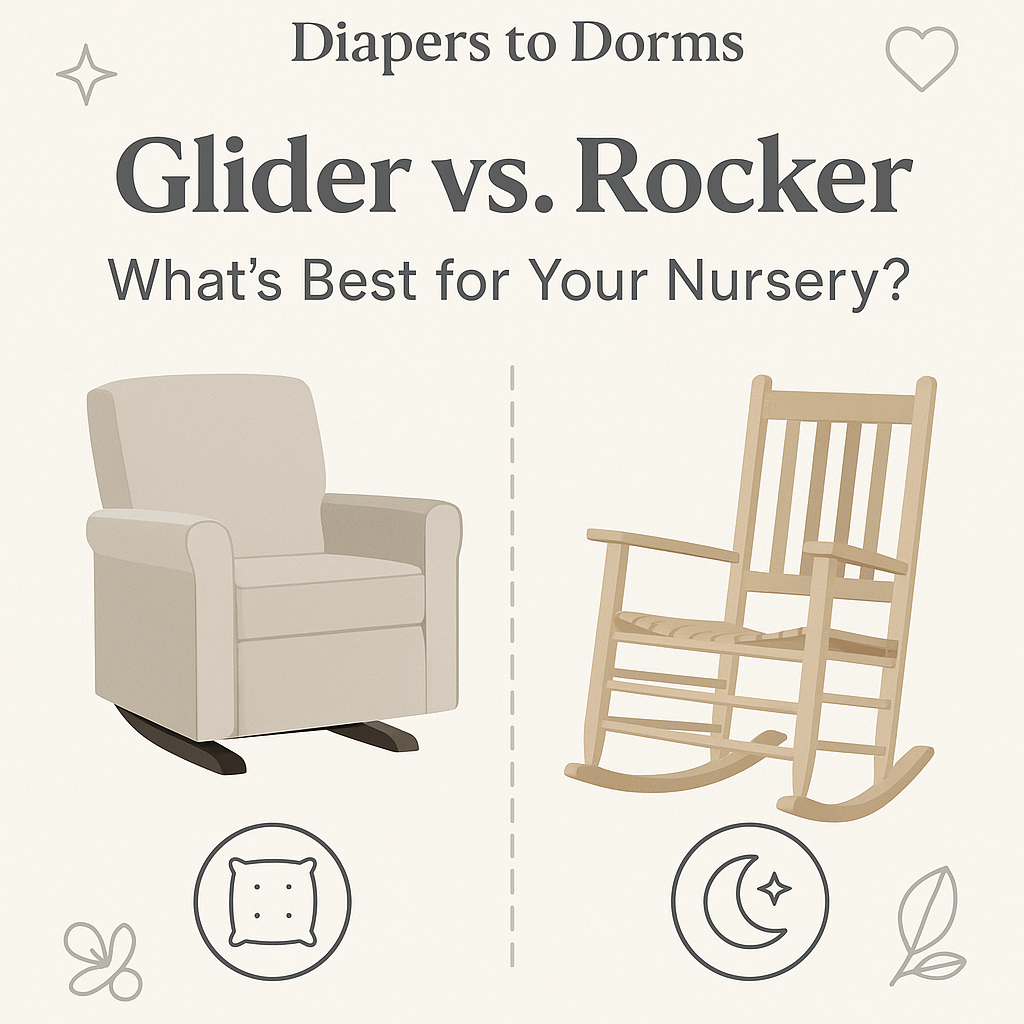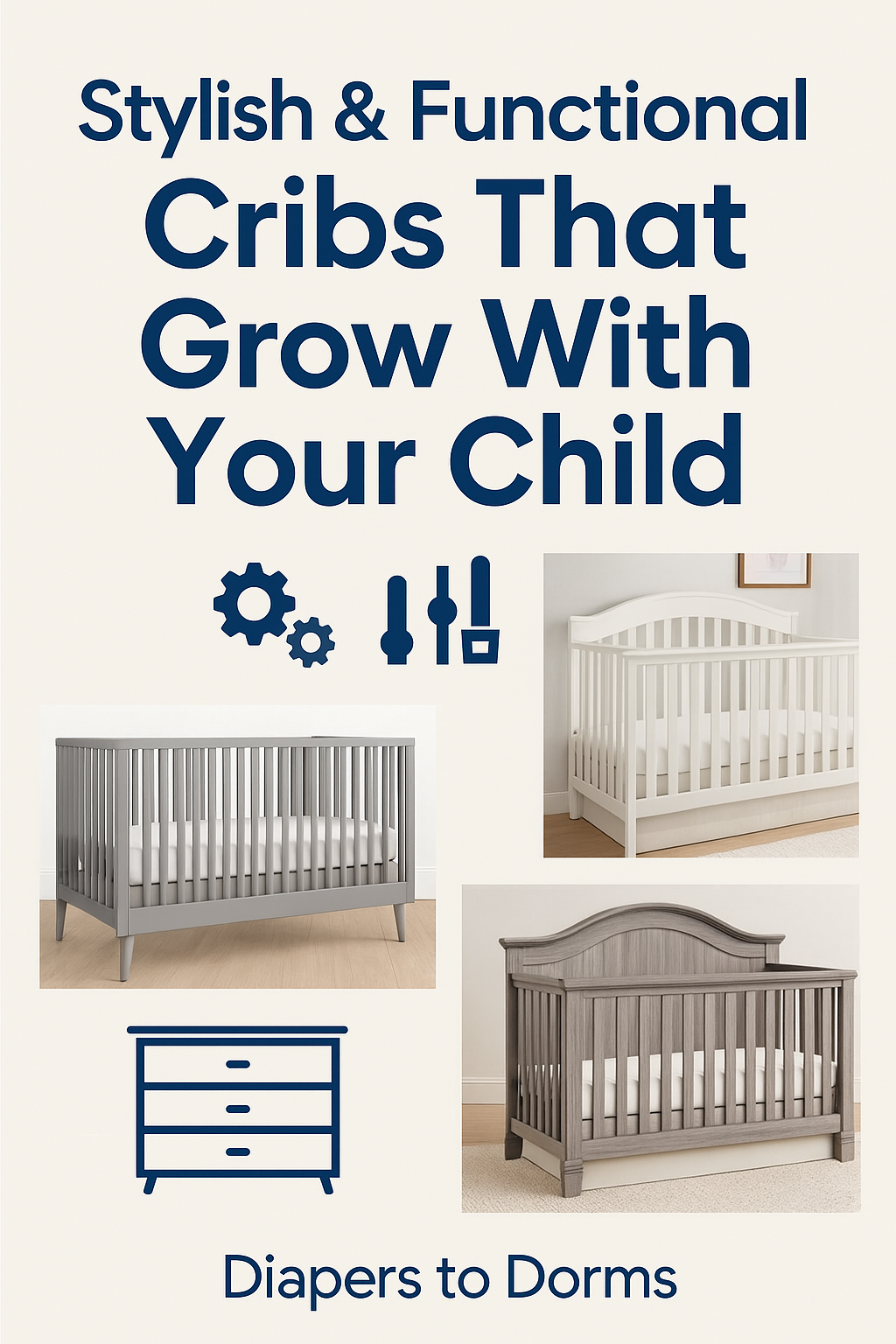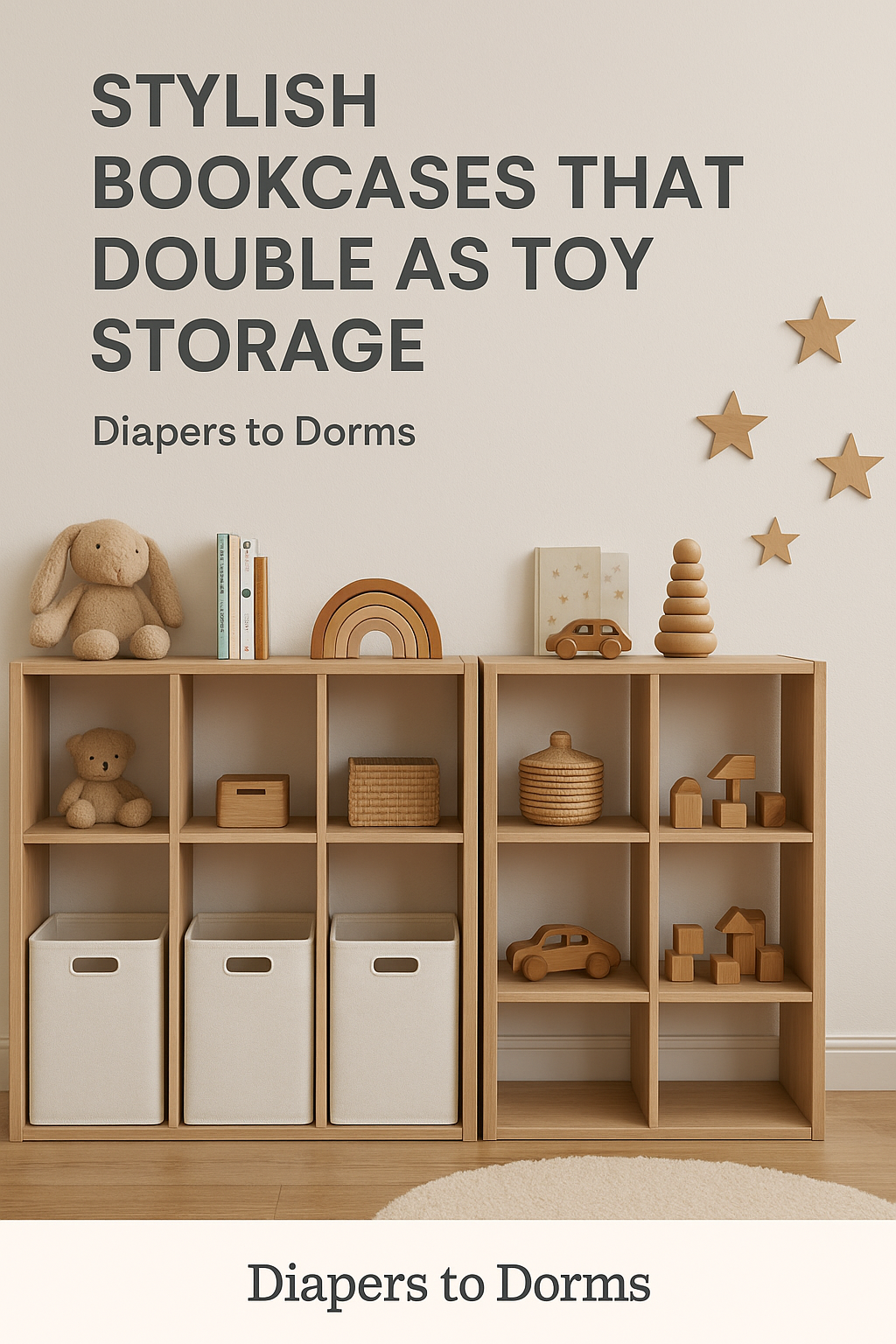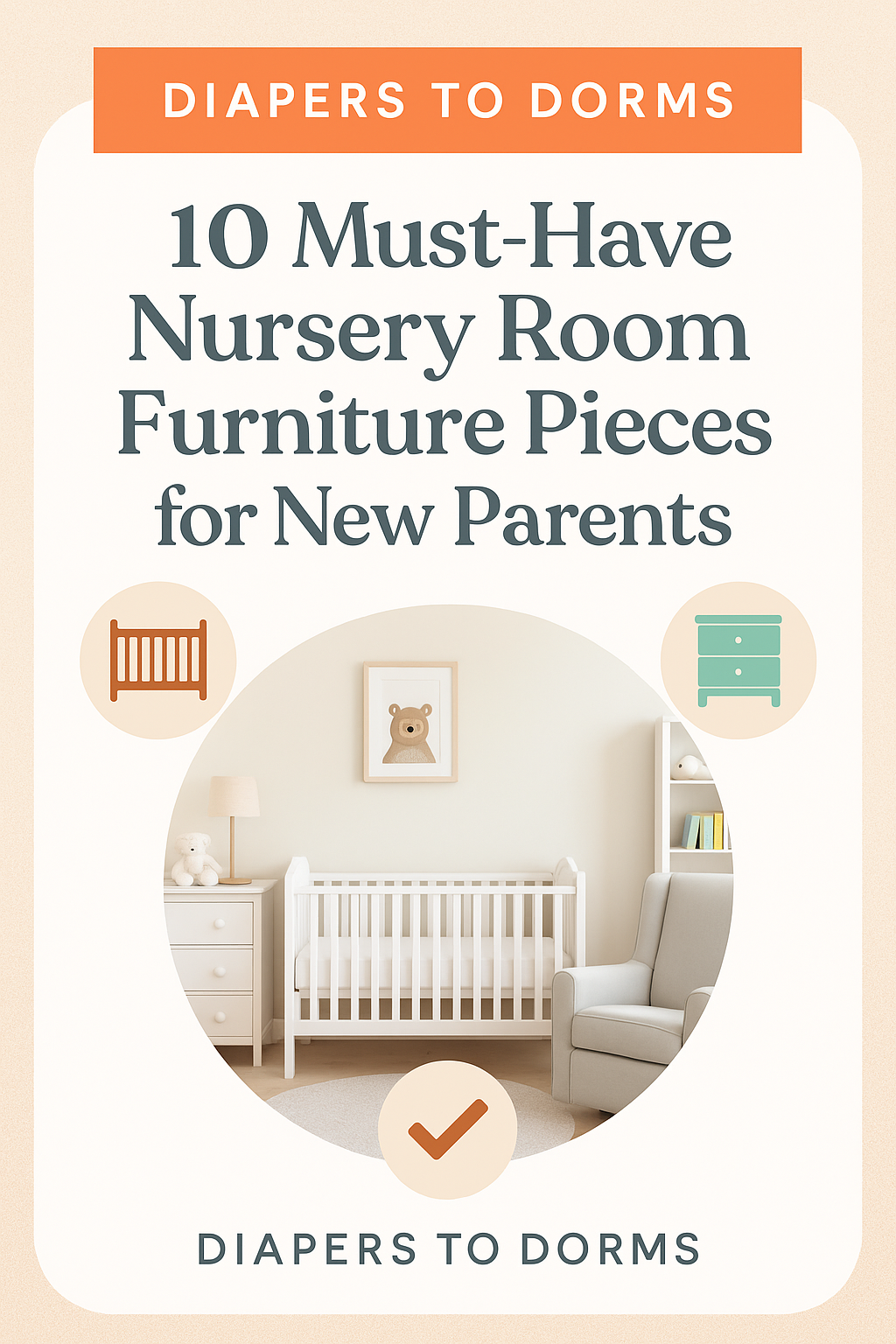Glider vs. Rocker: What’s Best for Your Nursery?
When you’re designing a nursery, you’ll quickly find that the seating you choose will become one of the most used pieces of furniture—from late-night feedings to early morning snuggles. A chair isn’t just about looks; it’s about comfort, durability, and how it supports both you and baby through all stages. Deciding between a rocker and a glider can feel overwhelming because both offer soothing motion and cozy comfort—but the right choice depends on your space, physical needs, and long-term plans. In this post, we’ll dig deeper into the differences, share what features really matter, and spotlight some excellent glider and rocker options that are in stock right now. Don’t forget to also check out our full guide on 10 Must-Have Nursery Room Furniture Pieces for New Parents to build the rest of your perfect nursery setup.
What Is a Rocker vs. What Is a Glider?
A rocking chair (rocker) is typically built with curved legs (runners) that allow the whole chair to move in an arc when you push forwards or backwards with your feet. The motion tends to be more pronounced, sometimes even rhythmic or bouncy depending on the curve of the runners. Rockers are often lighter in build because the base is simpler (no track or mechanism), which can make them easier to move or reposition in the room. However, that simplicity sometimes means they offer fewer features—less recline, no swivel, and often less padding—so comfort can depend heavily on design quality.
A glider, in comparison, operates on a stationary base with a track or other mechanical link that allows the seat to move back and forth without tilting or rocking the whole frame. The motion is usually smoother and more controlled (less bounce), which many parents find gentler for both themselves and babies (especially newborns). Gliders often come with added features—like swivels (to turn without moving the chair legs), reclining backs, or matching ottomans—for enhanced comfort. The trade-offs can be size (they take up more room), weight (they’re heavier), and higher cost compared to basic rockers. If you plan to spend many hours in the chair, the extra comfort of well-designed gliders may make a difference.
Many people also consider hybrid options: rocker-gliders or gliders that allow rocking and gliding combinations, or rocker-bases with added padding and arms to mimic glider comfort. These hybrids try to bring together the best of both worlds, though sometimes at a compromise in one area (for example, they might be bulkier or more expensive). One thing that’s consistent across most expert guides: look at your space, how often you’ll use the chair, and how much comfort and safety features matter. As noted by Wayfair, Pottery Barn Kids, and Nurture& in their comparison guides, these practical considerations often tip the scale.

Storkcraft Hoop Glider & Ottoman
$169.99
•
Wayfair + others

Babyletto Madison Swivel Glider
$449.00
•
Babyletto + others

Baby Relax Mikayla Swivel Glider Recliner
$529.99
•
buybuy BABY + others

Delta Children Adley Swivel Rocker/Glider Chair
$229.99
•
Delta Children + others

Pros & Cons Comparison
Here are deeper looks at what you gain or lose with each option:
| Feature | Glider – Advantages | Glider – Disadvantages |
|---|---|---|
| Motion & Comfort | Smoother, controlled gliding movement is easier on the back and more calming during long feeding sessions. Many gliders offer swivel and reclining sides, making it easier to shift position without disturbing your baby. Upholstery tends to be more generous (“roomier”) in both seat width and back height. Covered mechanisms in many models reduce risk of pinch points. Nurture&+1 | Larger footprint—needing more space behind and around the chair. Heavier, harder to move especially when assembled. More mechanical parts (recline, swivel, track) may mean more things that could need repair or wear. Typically higher priced. |
| Simplicity & Aesthetic | Rockers often have clean, classic design that fits many nursery styles (rustic, traditional, vintage). Simpler construction can mean fewer mechanical parts to worry about. Sometimes lighter in weight and easier to assemble, which can be helpful for new parents handling the setup. Lower cost options often abound. | Motion can be uneven or noisy depending on surface and build. Less variety of modern features like swivel, recline, or locking mechanisms. May not be as supportive for long sitting hours (in terms of lumbar or seat cushioning). Can slide on hard floors or shift if runs are smooth and no carpet / rug. |
Key Features to Consider
When selecting between glider or rocker (or hybrids), these specific features will affect your day-to-day comfort and how long the chair remains useful.
First, support is essential. Arm height and arm padding matter when you’re holding a baby, feeding, or using a nursing pillow. Back height should be sufficient so you’re not slouching, especially in late night or early morning sessions. Lumbar support or even an adjustable or padded lower back cushion can reduce fatigue. If the chair reclines, you’ll want a mechanism that’s easy to use (lever, pull tab, or release built into arm) without straining.
Second, fabric and ease of cleaning are huge. Babies spit up, hands get messy, and drinks spill often. Removable or wipe-able upholstery helps. Stain-resistant fabrics or tightly woven materials can make cleaning up easier. Coverage for arms, seat, and places where fabric meets mechanism is good so that dirt doesn’t accumulate. Always check wash / care instructions; some fabrics look good but are hard to keep clean or fade with frequent washes or exposure to sunlight.
Third, space, footprint, and mobility—make sure the chair fits comfortably where you plan to use it without blocking pathways. Measure the width, depth, and how far the chair needs to recline or glide or rock. Think about how close the chair will be to walls. Also consider the weight and how easy it is to assemble or move (for example, if you want to carry the chair up stairs or around). Features like built-in storage pockets, side pockets, or ottoman can add utility but also bulk.
How It Fits with the Rest of Your Nursery Furniture
Your glider or rocker won’t exist in isolation—it needs to work with your crib, dresser, changing table, shelves, lighting, rugs, and overall style. Pulling all those pieces together is what makes your nursery both functional and beautiful.
First, style coherence: If your nursery already has classic wood furniture with natural tones, a wooden rocker or a glider with a wood frame might tie in better. If your furniture leans modern—sleek, minimal lines—then choose a glider with clean upholstery, hidden mechanism, or subtle track designs. Don’t forget finishes: the color/stain of wood, metallic accents (nails, screws, handles), or fabric tones need to speak to each other to avoid visual clash.
Second, balance of bulk: A large recliner glider can dominate a room, which may be fine if you have space, but if not, pairing it with more streamlined pieces helps the room feel balanced. For example, using a slim dresser, floating shelves instead of large bookcases, or lighter window treatments can allow the chair to stand out without overwhelming. Rugs also help: a soft rug under the chair can reduce noise, protect flooring, and define a cozy seating area.
Third, function alignment: Think ahead—will the chair be used only in the nursery, or later moved into another room? Chairs with timeless style or portable design can transition well beyond infancy. Also consider features of your nursery furniture checklist: matching storage, safe height surfaces, strong lighting for nighttime, and comfortable surfaces for feeding. For more on assembling the full nursery furniture lineup, check our post 10 Must-Have Nursery Room Furniture Pieces for New Parents.
Here are some pick summaries:
- Willa Arlo Mackay Swivel Reclining Glider: A modern style glider with reclining capability and soft upholstery. Its 360° swivel & track arms give a blend of comfort and versatility—good if you’ll be moving between nursing, burping, or just relaxing. Mid-price range, so good value for the quality.
- Baby Relax Mikayla Swivel Glider Recliner: Offers a plush, deep seat with tufted back, ideal for longer sessions. The swivel + gliding motion gives flexibility. The pull-tab or lever to recline is helpful during those middle-of-night feedings. Fabric looks durable, with decent reviews.
- Storkcraft Tuscany Glider & Ottoman: Comes with matching ottoman, which is a big bonus if you want to put feet up or nurse in reclined position. Swirl cushion pattern adds visual interest. Solid wood frame gives sturdiness. Great middle ground between comfort & affordability.
- Baby Relax Rylan 4‑in‑1 Swivel Glider Rocker Recliner: Very versatile—glide, rock, recline, and full swivel. Cushioning is thick, especially in the back and arms. Might be bulkier, so check measurements carefully. Excellent pick if you want one chair to serve many roles.
- Delta Children Blair Slim Nursery Glider: Slim design works well in smaller nurseries or tighter corners. Offers gliding and rocking in one, which gives options. Upholstered and cushioned, but not overstuffed—good selection if you want comfort without bulk. Color options help it match different decor palettes.
- Soho Baby Coventry Swivel Glider & Recliner: Luxury fabric (bouclé) and upscale feel. 360° swivel, recline, and glide functions make it a high-comfort pick. Quiet metal mechanisms are a plus. On the pricier side, but looks and feel are premium.
- Angel Line Windsor Glider & Ottoman: More traditional style (Windsor-inspired), with ottoman included and some handy storage pockets. Spot-cleanable cushions, solid wood frame—nice compromise between classic design and function. Budget-friendly option. Good if traditional style appeals but you still want function.
- DaVinci Erin Recliner & Swivel Glider: Stylish build, high back and plush seat, 360° swivel adds flexibility. Fabric looks modern, often in “pine green” or other trending hues. Safety-tested well, good capacity. A solid investment piece that should serve past the infant stage.
Real-World Tips & Considerations
Using parent reviews and expert advice helps bring out what works in real life (not just specs).
Many parents report that gliders feel gentler and more controlled at night, especially when babies are very young and need frequent soothing. The smooth gliding motion tends to produce less creaking and less disturbance to partners or other children in the house. For nighttime feedings, the ability to recline or swivel so you don’t twist awkwardly can reduce back and shoulder strain. On the flip side, rockers are often lighter and easier to move if your nursery isn’t where you spend all your time.
Another consideration is safety and finger pinch risk: gliders with covered tracks or locking mechanisms are safer for households with curious toddlers or pets. Rocking chairs have open arcs under them, which sometimes present hazards if there are loose rugs or toys around. Upholstery covering mechanical parts (swivel, recline levers) helps avoid accidental pinches. Many expert-led comparisons also note that quieter mechanisms (ball bearings, enclosed tracks) are preferable for sleep environments. Nurture&+1
Durability and long-term usefulness really matter: does the chair feel like it will last several years? Consider the weight limit, how easy it is to reupholster, whether cushions can be replaced or cleaned, and how good the warranty or return policy is. Chairs that transition from nursery to living room or reading nook are a smarter spend. Also, think about resale or gift potential: styles that are neutral or classic tend to age better. Some parents find that “feature overload” (lots of recline, swivel, etc.) is nice but maybe more than they truly need—so choosing features you will actually use is key.
We’d love to hear from you: which features do you value most in a nursery chair—smooth glide, rocking motion, recline, or something else? Drop a comment below to share your thoughts or experiences. If you found this post helpful, please share it with your friends or on social so other new parents can benefit too. Don’t forget to explore our other guides (like 10 Must-Have Nursery Room Furniture Pieces for New Parents) for help designing a nursery that’s beautiful, functional, and made with love.




Post Comment